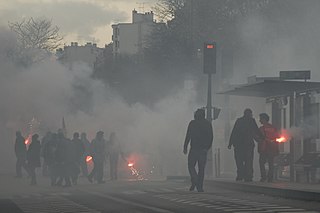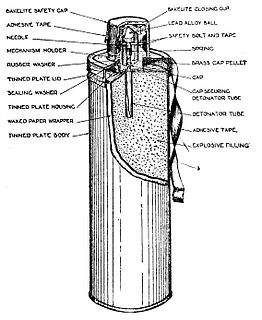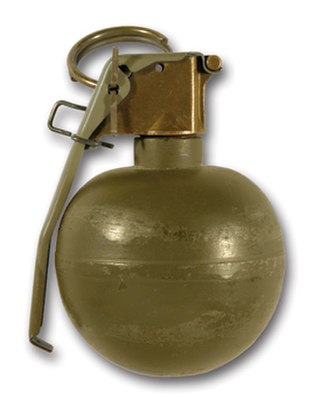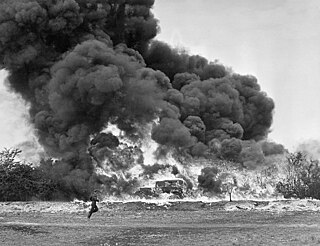| No 76, Self Igniting Phosphorus | |
|---|---|
| Type | Incendiary grenade |
| Place of origin | United Kingdom |
| Production history | |
| No. built | 6,000,000. [1] |
| Specifications | |
| Filling | phosphorus, benzene |
Detonation mechanism | Impact |
The No. 76 Special Incendiary Grenade also commonly known as the A.W. bomb or SIP Grenade (Self Igniting Phosphorus) is an incendiary grenade based on white phosphorus used during World War II.

World War II, also known as the Second World War, was a global war that lasted from 1939 to 1945. The vast majority of the world's countries—including all the great powers—eventually formed two opposing military alliances: the Allies and the Axis. A state of total war emerged, directly involving more than 100 million people from over 30 countries. The major participants threw their entire economic, industrial, and scientific capabilities behind the war effort, blurring the distinction between civilian and military resources. World War II was the deadliest conflict in human history, marked by 50 to 85 million fatalities, most of whom were civilians in the Soviet Union and China. It included massacres, the genocide of the Holocaust, strategic bombing, premeditated death from starvation and disease, and the only use of nuclear weapons in war.
Contents
On 29 July 1940, manufacturers Albright & Wilson of Oldbury demonstrated to the Royal Air Force how their white phosphorus could be used to ignite incendiary bombs. The demonstration involved throwing glass bottles containing a mixture of petrol and phosphorus at pieces of wood and into a hut. On breaking, the phosphorus was exposed to the air and spontaneously ignited; the petrol also burned resulting in a fierce fire. Because of safety concerns, the RAF was not interested in white phosphorus as a source of ignition, but the idea of a self-igniting petrol bomb took hold. Initially known as an A.W. bomb, it was officially named the No 76 Grenade, but more commonly known as the SIP (Self Igniting Phosphorus) grenade. The perfected list of ingredients was white phosphorus, benzene, water and a two-inch strip of raw rubber; all in a half-pint bottle sealed with a crown stopper. [2] Over time, the rubber would slowly dissolve making the contents slightly sticky and the mixture would separate into two layers – this was intentional and the grenade should not be shaken to mix the layers as this would only delay ignition. [3] When thrown against a hard surface, the glass would shatter and the contents would instantly ignite liberating choking fumes of phosphorus pentoxide and sulphur dioxide as well as producing a great deal of heat. [2]

The Royal Air Force (RAF) is the United Kingdom's aerial warfare force. Formed towards the end of the First World War on 1 April 1918, it is the oldest independent air force in the world. Following victory over the Central Powers in 1918 the RAF emerged as, at the time, the largest air force in the world. Since its formation, the RAF has taken a significant role in British military history. In particular, it played a large part in the Second World War where it fought its most famous campaign, the Battle of Britain.

Phosphorus is a chemical element with symbol P and atomic number 15. Elemental phosphorus exists in two major forms, white phosphorus and red phosphorus, but because it is highly reactive, phosphorus is never found as a free element on Earth. It has a concentration in the Earth's crust of about one gram per kilogram. With few exceptions, minerals containing phosphorus are in the maximally oxidized state as inorganic phosphate rocks.

Elemental phosphorus can exist in several allotropes, the most common of which are white and red solids. Solid violet and black allotropes are also known. Gaseous phosphorus exists as diphosphorus and atomic phosphorus.
Strict instructions were issued to store the grenades safely, preferably underwater and certainly never in a house. [2] Mainly issued to the Home Guard as an anti-tank weapon, it was produced in vast numbers; by August 1941 well over 6,000,000 had been manufactured. [4]
The grenade could either be thrown by hand, or fired from the Northover projector, a simple mortar; a stronger container was needed for the latter and the two types were colour-coded. As any breakage of the flask would be dangerous, storage under water was recommended.

A mortar is usually a simple, lightweight, man portable, muzzle-loaded weapon, consisting of a smooth-bore metal tube fixed to a base plate with a lightweight bipod mount and a sight. They launch explosive shells in high-arcing ballistic trajectories. Mortars are typically used as indirect fire weapons for close fire support with a variety of ammunition.
There were many who were sceptical about the efficacy of Molotov cocktails and SIP grenades against the more modern German tanks. Weapon designer Stuart Macrae witnessed a trial of the SIP grenade at Farnborough: "There was some concern that, if the tank drivers could not pull up quickly enough and hop out, they were likely to be frizzled to death, but after looking at the bottles they said they would be happy to take a chance." [5] The drivers were proved right; trials on modern British tanks confirmed that Molotov and SIP grenades caused the occupants of the tanks "no inconvenience whatsoever". [6]
Colonel Robert Stuart Macrae TD was an inventor best known for his work at MD1 during the Second World War, his best known invention being the sticky bomb.
The Home Guard hid caches of these grenades during the war for use in the event of an invasion. Not all locations were officially recorded and some caches were lost. [7] Occasionally, the caches are discovered by builders digging foundations. In all cases, the grenades are still found to be dangerous and typically are destroyed via a controlled explosion.













